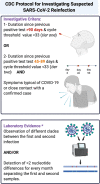The Importance and Challenges of Identifying SARS-CoV-2 Reinfections
- PMID: 33361342
- PMCID: PMC8092746
- DOI: 10.1128/JCM.02769-20
The Importance and Challenges of Identifying SARS-CoV-2 Reinfections
Abstract
Reports of severe acute respiratory syndrome coronavirus 2 (SARS-CoV-2) reinfection have raised important questions about the strength and durability of the immune response to primary infection, which are key factors in predicting the course of the pandemic. Identifying reinfection requires detecting the virus at two different time points and using viral genomic data to distinguish reinfection from persistent viral carriage. This process is hindered by challenges of logistics and capacity, such as banking samples from primary infection and performing viral genome sequencing. These challenges may help to explain why very few cases have been described to date. In addition, reinfection may be a rare phenomenon, but detailed prospective studies are needed to rigorously assess its frequency. To provide context for future investigations of SARS-CoV-2 reinfection, we review 16 cases that have been published to date or are available in preprint. Reinfection occurred across demographic spectra and in patients whose initial infections were both asymptomatic/mild and moderate/severe. For cases in which severity could be compared between episodes, half of reinfections were less severe, raising the possibility of partial immune protection. Although many patients had a positive total immunoglobulin or IgG result at the time of reinfection, very little examination of their immune response was performed. Further work is needed to elucidate the frequency, determinants, and consequences of SARS-CoV-2 reinfection. Establishing the necessary frameworks for surveillance and investigation will rely heavily on clinical laboratories and clinical investigators, and we propose several considerations to guide the medical community in identifying and characterizing SARS-CoV-2 reinfections.
Keywords: COVID-19; SARS-CoV-2; reinfection; viral immunity.
Copyright © 2021 American Society for Microbiology.
Figures

References
-
- To KK-W, Hung IF-N, Ip JD, Chu AW-H, Chan W-M, Tam AR, Fong CH-Y, Yuan S, Tsoi H-W, Ng AC-K, Lee LL-Y, Wan P, Tso EY-K, To W-K, Tsang DN-C, Chan K-H, Huang J-D, Kok K-H, Cheng VC-C, Yuen K-Y. 25 August 2020. Coronavirus disease 2019 (COVID-19) re-infection by a phylogenetically distinct severe acute respiratory syndrome coronavirus 2 strain confirmed by whole genome sequencing. Clin Infect Dis doi: 10.1093/cid/ciaa1275. - DOI - PMC - PubMed
-
- Tillett RL, Sevinsky JR, Hartley PD, Kerwin H, Crawford N, Gorzalski A, Laverdure C, Verma SC, Rossetto CC, Jackson D, Farrell MJ, Van Hooser S, Pandori M. 2020. Genomic evidence for reinfection with SARS-CoV-2: a case study. Lancet Infect Dis 21:52–58. doi: 10.1016/S1473-3099(20)30764-7. - DOI - PMC - PubMed
-
- Gupta V, Bhoyar RC, Jain A, Srivastava S, Upadhayay R, Imran M, Jolly B, Divakar MK, Sharma D, Sehgal P, Ranjan G, Gupta R, Scaria V, Sivasubbu S. 23 September 2020. Asymptomatic reinfection in two healthcare workers from India with genetically distinct severe acute respiratory syndrome coronavirus 2. Clin Infect Dis doi: 10.1093/cid/ciaa1451. - DOI - PMC - PubMed
-
- Suthar MS, Zimmerman M, Kauffman R, Mantus G, Linderman S, Vanderheiden A, Nyhoff L, Davis C, Adekunle S, Affer M, Sherman M, Reynolds S, Verkerke H, Alter DN, Guarner J, Bryksin J, Horwath M, Arthur C, Saakadze N, Smith GH, Edupuganti S, Scherer EM, Hellmeister K, Cheng A, Morales JA, Neish AS, Stowell SR, Frank F, Ortlund E, Anderson E, Menachery V, Rouphael N, Metha A, Stephens DS, Ahmed R, Roback J, Wrammert J. 8 May 2020. Rapid generation of neutralizing antibody responses in COVID-19 patients. medRxiv doi: 10.1101/2020.05.03.20084442. - DOI - PMC - PubMed
Publication types
MeSH terms
LinkOut - more resources
Full Text Sources
Other Literature Sources
Medical
Miscellaneous

